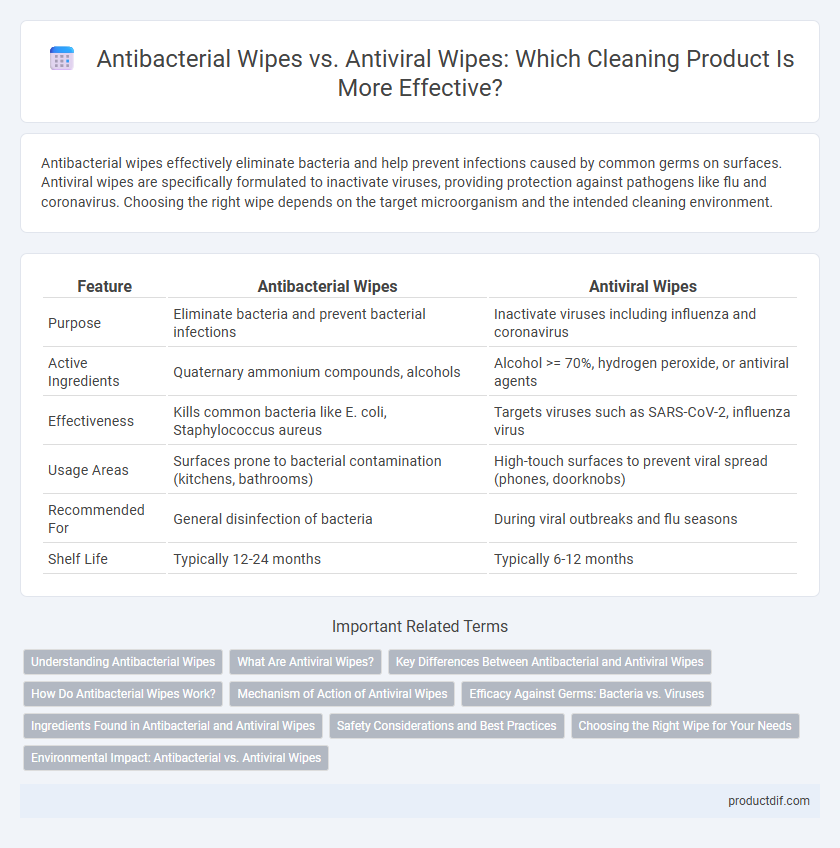Antibacterial wipes effectively eliminate bacteria and help prevent infections caused by common germs on surfaces. Antiviral wipes are specifically formulated to inactivate viruses, providing protection against pathogens like flu and coronavirus. Choosing the right wipe depends on the target microorganism and the intended cleaning environment.
Table of Comparison
| Feature | Antibacterial Wipes | Antiviral Wipes |
|---|---|---|
| Purpose | Eliminate bacteria and prevent bacterial infections | Inactivate viruses including influenza and coronavirus |
| Active Ingredients | Quaternary ammonium compounds, alcohols | Alcohol >= 70%, hydrogen peroxide, or antiviral agents |
| Effectiveness | Kills common bacteria like E. coli, Staphylococcus aureus | Targets viruses such as SARS-CoV-2, influenza virus |
| Usage Areas | Surfaces prone to bacterial contamination (kitchens, bathrooms) | High-touch surfaces to prevent viral spread (phones, doorknobs) |
| Recommended For | General disinfection of bacteria | During viral outbreaks and flu seasons |
| Shelf Life | Typically 12-24 months | Typically 6-12 months |
Understanding Antibacterial Wipes
Antibacterial wipes are designed to eliminate bacteria by targeting their cell walls and disrupting their reproduction, effectively reducing bacterial contamination on surfaces. These wipes commonly contain active ingredients such as benzalkonium chloride or alcohol, which are known for their efficacy against a broad spectrum of bacteria. Understanding their limitations, antibacterial wipes do not guarantee elimination of viruses or fungi, making them less effective in controlling viral infections compared to antiviral wipes.
What Are Antiviral Wipes?
Antiviral wipes are cleaning products formulated to eliminate or deactivate viruses on various surfaces, reducing the risk of viral transmission. These wipes typically contain active ingredients like alcohol, quaternary ammonium compounds, or hydrogen peroxide, which target and destroy viral particles effectively. Unlike antibacterial wipes that focus on killing bacteria, antiviral wipes are specifically designed to combat viruses such as influenza, coronavirus, and other pathogens.
Key Differences Between Antibacterial and Antiviral Wipes
Antibacterial wipes target and eliminate bacteria such as E. coli and Staphylococcus, while antiviral wipes are formulated to deactivate viruses like influenza and coronavirus. The chemical agents in antibacterial wipes often include benzalkonium chloride or alcohol, effective against bacterial cell walls, whereas antiviral wipes use ingredients like ethanol or quaternary ammonium compounds to disrupt viral envelopes. Understanding these distinctions ensures proper selection for sanitizing surfaces depending on the microbial threat present.
How Do Antibacterial Wipes Work?
Antibacterial wipes contain active ingredients like benzalkonium chloride or triclosan that disrupt bacterial cell membranes, causing their death and preventing bacterial growth on surfaces. These wipes target specific bacteria but are not effective against viruses, as viral structures require different mechanisms for neutralization. Their efficacy depends on proper contact time and thorough surface coverage to ensure bacteria are effectively eliminated.
Mechanism of Action of Antiviral Wipes
Antiviral wipes work by disrupting the lipid envelope or protein coat of viruses, effectively inactivating viral particles on surfaces. These wipes often contain compounds such as ethanol, quaternary ammonium compounds, or hydrogen peroxide that target and break down viral structures, preventing replication and transmission. Unlike antibacterial wipes that primarily target bacterial cell walls and metabolic functions, antiviral wipes are specifically formulated to neutralize viral pathogens including enveloped and non-enveloped viruses.
Efficacy Against Germs: Bacteria vs. Viruses
Antibacterial wipes are formulated to eliminate bacteria and are effective against common pathogens such as E. coli and Staphylococcus aureus. Antiviral wipes specifically target viruses, including influenza, coronavirus, and norovirus, by disrupting the viral envelope. Selecting the appropriate wipe depends on the primary germ threat, as antibacterial wipes may not neutralize viruses, while antiviral wipes provide broader protection against viral infections.
Ingredients Found in Antibacterial and Antiviral Wipes
Antibacterial wipes commonly contain ingredients such as benzalkonium chloride, triclosan, or alcohol-based compounds targeting bacteria on surfaces. Antiviral wipes often include similar alcohol concentrations, but may also feature hydrogen peroxide or quaternary ammonium compounds specifically effective against viruses like influenza or coronaviruses. Understanding the active ingredients helps select the appropriate wipe for either bacterial or viral disinfection needs.
Safety Considerations and Best Practices
Antibacterial wipes are formulated to eliminate bacteria and are often less aggressive on skin, making them suitable for frequent use on hands and surfaces. Antiviral wipes target viruses, including enveloped viruses like influenza and coronaviruses, but may contain stronger chemicals requiring careful ventilation and protective gloves. Best practices include reading labels for active ingredients, adhering to contact times for efficacy, and avoiding overuse to prevent skin irritation or chemical exposure.
Choosing the Right Wipe for Your Needs
Antibacterial wipes are designed to eliminate bacteria and are ideal for everyday cleaning of surfaces prone to bacterial contamination, such as kitchen counters and bathroom fixtures. Antiviral wipes target viruses, making them essential during flu seasons or viral outbreaks to reduce the spread of pathogens like influenza and coronavirus. Selecting the right wipe depends on your specific hygiene needs, with antibacterial wipes suited for general cleaning and antiviral wipes recommended for enhanced protection against viral infections.
Environmental Impact: Antibacterial vs. Antiviral Wipes
Antibacterial wipes often contain chemicals like triclosan and benzalkonium chloride, which can contribute to water pollution and disrupt aquatic ecosystems when disposed of improperly. Antiviral wipes generally use alcohol-based solutions that tend to evaporate quickly, reducing long-term environmental toxicity but still generate significant plastic waste due to single-use packaging. Both types of wipes contribute to landfill waste, emphasizing the need for biodegradable alternatives and responsible disposal methods to minimize their environmental footprint.
Antibacterial wipes vs Antiviral wipes Infographic

 productdif.com
productdif.com